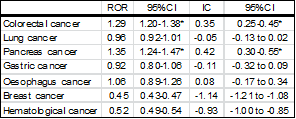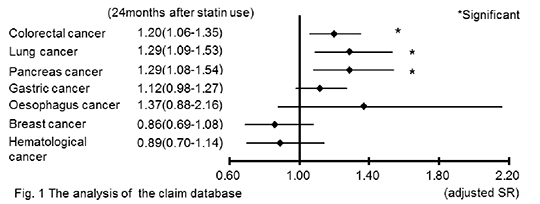Association between statin use and cancers: Data mining of a spontaneous reporting database and a claim database The interest has been focused on the potential risk of cancer associated with stain use. However, it remains uncertain whether statin therapy is associated with cancer (1). The aim of our study was to examine the association of statin use and the risk of seven major cancers (colorectal cancer, lung cancer, pancreas cancer, gastric cancer, oesophagus cancer, breast cancer, and hematological cancer) by employing different methodologies, algorithms, and databases. The data from the first quarter of 2004 through 2012 were downloaded from the US Food and Drug Administration Adverse Event Reporting System (FAERS). A total of 54,841,322 drug-reaction pairs among 3,308,116 reports were analysed. The reporting odds ratio (ROR) (2) and the information component (IC) (3) were used to detect the risk signal. The lower limit of the 95% confidence interval (95% CI) of ROR ˃ 1, and IC ˃ 0 indicate risk signals. Furthermore, employing the claim database contains 1.2 million insured persons, the event sequence symmetry analysis (ESSA) was used to identify the risk of cancer after using statins over the period of January 2005 to July 2013.The ESSA is a method to investigate the association between the use of certain target drugs and potential adverse events (4). The crude sequence ratio (SR) was defined as the ratio of the number of patients newly diagnosed with cancers after the initiation of statins versus the number of patients newly diagnosed with cancers before the initiation of statins. The lower limit of the 95% CI of SR > 1 signified the risk of cancers. This study was approved by the Ethics Committee of Kinki University School of Pharmacy. The Visual Mining Studio software (version 8.0; Mathematical Systems, Inc. Tokyo, Japan) was used in the present study. Tab. 1 The analysis of the FAERS database *Significant
The significant signals for colorectal cancer and pancreas cancer were found for the whole class of statins in analyses of both the FAERS database and the claim database (Tab. 1 and Fig. 1).
In summary, multi-methodological approaches using different methodologies, algorithms, and database suggest that statin use is associated with an increased risk for colorectal and pancreas cancers. The biological mechanism is uncertain; however, the risk of colorectal and pancreas cancers associated with statin use is important and should be closely monitored in clinical practice. (1) Kuoppala J et al. (2008). Eur J Cancer 44: 2122-2132. (2) van Puijenbroek EP et al. (2002). Pharmacoepidemiol Drug Saf 11: 3-10. (3) Bate A et al. (1998). Eur J Clin Pharmacol 54: 315-321. (4) Hallas J (1996). Epidemiology 7:478-784.
|



